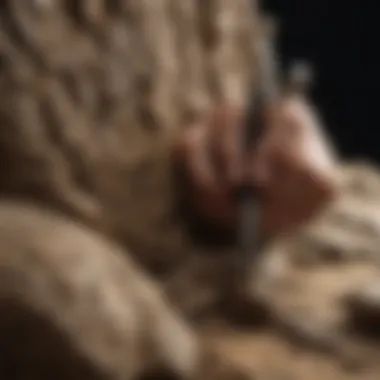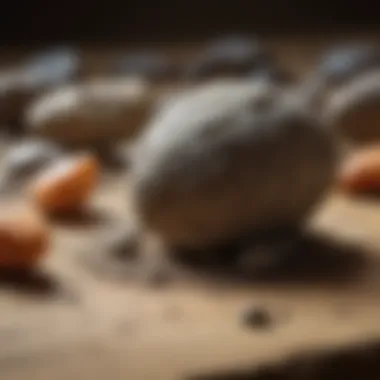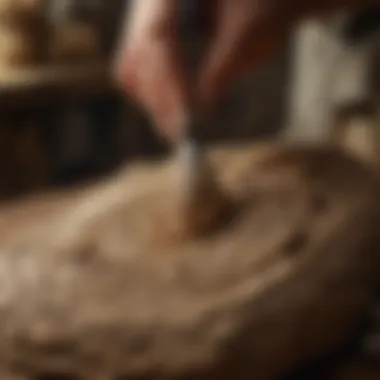Mastering the Art of Rock Carving with a Dremel Tool: A Comprehensive Guide for Enthusiasts


Rock and Fossil Identification
When delving into the intricate art of carving rock with a Dremel, it is essential to first understand the foundational aspects of rock and fossil identification. Enthusiasts embarking on this journey need to familiarize themselves with the various types of rocks and fossils, each possessing unique characteristics awaiting discovery. Being able to discern these characteristics is crucial in selecting the most suitable rocks for carving. Utilizing specialized tools for identification further enhances the ability to differentiate between different rock and fossil types, ensuring a more informed and enriching carving experience.
Collecting Tips and Techniques
Cultivating a collection of rocks and fossils entails more than mere acquisition – it requires a keen eye, knowledge of best practices, and refined techniques. Avid collectors will benefit from insights into the art of collecting, from honing observation skills to locating prime collecting sites teeming with geological treasures. Mastering how to safely extract specimens guarantees the preservation of delicate formations while enriching one's collection with remarkable finds. Embracing best practices in collecting not only enhances the quality but also the joy of expanding one's rock and fossil treasury.
Preservation and Display
Assembling a captivating collection of rocks and fossils goes beyond acquisition and preservation plays a vital role in safeguarding the integrity and beauty of these geological wonders. Techniques for effective preservation ensure that the specimens retain their visual allure and scientific value over time. Knowing the proper storage methods is essential in maintaining the condition of each piece, safeguarding it for generations to come. Additionally, exploring creative display ideas allows enthusiasts to showcase their collection in a visually striking and informative manner, turning a personal collection into an engaging exhibit.
Geological Insights
Delving into the realm of rock carving with a Dremel unveils not only exceptional artistic opportunities but also profound geological insights. Understanding the geological formations and processes that have shaped rocks and fossils adds a layer of appreciation to each carving endeavor. Exploring the historical significance of rocks and fossils provides enthusiasts with a deeper connection to the earth's past, offering glimpses into ancient worlds. Uncovering notable discoveries in the field of geology further enriches the carving experience, infusing it with a sense of exploration and discovery.
Introduction
In the realm of carving fine art, the meticulous craft of shaping and sculpting rocks with a Dremel tool stands as a testament to human creativity and precision. This article serves as a definitive guide to enthusiasts of rock and fossil collections on RelictVibe, delving deep into the art of rock carving with a Dremel. From the initial stages of selecting the most suitable rocks to the delicate techniques required for intricate designs, this guide aims to equip enthusiasts with the necessary knowledge and skills to create stunning carved masterpieces. The allure of rock carving lies not only in the final aesthetic beauty it brings but also in the therapeutic and meditative experience it provides to the artist. As you embark on this artistic journey, understanding the nuances of this craft will open doors to a world of creativity and expression that transcends conventional art forms. This article seeks to unravel the mysteries and intricacies of rock carving with a Dremel, offering a wealth of information and insights for both novice and seasoned enthusiasts alike.
Understanding the Basics of Rock Carving


Understanding the basics of rock carving is foundational to mastering the art of sculpting rocks with a Dremel tool. In this guide dedicated to enthusiasts of rock and fossil collecting on the RelictVibe platform, grasping the fundamental principles of rock carving sets the stage for creating intricate and captivating pieces of art. By delving into the basics, enthusiasts can appreciate the different types of rocks suitable for carving, understand the essential tools required, and internalize crucial safety precautions necessary for a successful carving experience.
Selecting the Right Rock for Carving
Choosing the appropriate rock for carving is a critical first step in the artistic process. The type of rock selected influences the ease of carving, the level of detail achievable, and the overall outcome of the artwork. Enthusiasts should consider factors such as hardness, texture, and composition when identifying rocks suited for their carving projects. Selections may range from softer sedimentary rocks like limestone to harder igneous rocks such as granite, each offering unique challenges and advantages in the carving process.
Tools and Equipment Needed
Equipping oneself with the essential tools and equipment is indispensable for a successful rock carving endeavor. In this section, enthusiasts will explore a curated list of tools specific to rock carving with a Dremel. From the versatile Dremel rotary tool itself to a variety of specialized attachments like diamond burrs and grinding stones, each tool plays a vital role in shaping and detailing the rock. Additionally, accessories such as safety goggles, dust masks, and protective gloves are imperative for ensuring a safe and comfortable working environment.
Safety Precautions to Follow
Prioritizing safety measures is paramount when engaging in rock carving activities. This subsection highlights the importance of adhering to safety protocols to prevent accidents and safeguard personal well-being. Enthusiasts will learn about best practices for wearing protective gear, maintaining a clutter-free workspace, and handling sharp tools with care. By following these safety precautions diligently, enthusiasts can mitigate potential risks and focus on honing their rock carving skills with confidence and peace of mind.
Mastering the Art of Carving with a Dremel
Mastering the Art of Carving with a Dremel is a pivotal section within this comprehensive guide on rock carving. It delves deeply into the foundational skills and techniques necessary to become proficient in using a Dremel tool for intricate rock carvings. By mastering this art, enthusiasts can unlock a world of creativity and precision in their work, allowing them to create stunning pieces that will captivate viewers.
Understanding Different Dremel Attachments
Understanding the myriad Dremel attachments available is essential for rock carving enthusiasts looking to hone their craft. Each attachment serves a distinct purpose, from cutting and shaping to detailing and polishing. By comprehensively exploring these attachments, artists can leverage the full potential of their Dremel tool, achieving intricate details and textures in their carvings.


Step-by-Step Carving Techniques
The Step-by-Step Carving Techniques section breaks down the process of rock carving into manageable steps, guiding enthusiasts through the intricate art form. From outlining designs to refining details, this segment offers a structured approach to carving with a Dremel tool. By following these detailed steps, artists can enhance their skills and produce refined, professional-quality rock carvings.
Finishing and Polishing Your Carved Rock
Finishing and Polishing plays a crucial role in bringing a rock carving to life. This segment delves into the techniques and tools needed to refine and enhance the final piece. From smoothing rough edges to adding a lustrous sheen, the finishing touches elevate the overall aesthetics of the carved rock. By paying attention to these final details, enthusiasts can showcase their craftsmanship and attention to detail in their creations.
Exploring Advanced Rock Carving Techniques
In the realm of rock carving using a Dremel tool, advancing from basic techniques to more intricate methods opens a gateway to creativity and precision. This section serves as a crucial segment in our comprehensive guide as it delves into the nuances of exploring advanced rock carving techniques, elevating enthusiasts' craftsmanship to new heights. By mastering these techniques, enthusiasts can breathe life into their creations, infusing them with intricate designs, patterns, and textures that showcase their artistry.
Intricate Designs and Patterns
When delving into advanced rock carving techniques, understanding intricate designs and patterns is paramount. By intricately incorporating geometric shapes, floral patterns, or even detailed landscapes into your carvings, you can elevate the aesthetic appeal and storytelling aspect of your creations. This subsection will guide enthusiasts on how to conceptualize and execute these complex designs, aiding them in pushing the boundaries of their creativity and craftsmanship.
Adding Texture and Depth to Your Carvings
Adding texture and depth to carvings is a fundamental aspect of advanced rock carving techniques. By mastering the art of creating depth through layers, adding textural elements like grooves or ridges, and playing with light and shadow, enthusiasts can bring a sense of realism and dimensionality to their rock carvings. This section will explore various methods and tools to enhance textures and depths in carvings, providing insights on how to create visually striking and tactile artworks.
Utilizing Dremel Tips for Precision Work


Precision is key when it comes to advanced rock carving, and utilizing Dremel tips effectively can significantly enhance the level of detail and accuracy in your carvings. Whether it's achieving intricate engravings, fine detailing, or perfecting intricate curves, selecting the right Dremel tip for the job is crucial. This subsection will delve into the various types of Dremel tips available, their specific applications, and techniques for achieving precision work that elevates the quality of your rock carvings to professional standards.
Preserving and Displaying Your Carved Rock
In the realm of rock carving with a Dremel tool, preserving and displaying your crafted pieces holds significant importance. Upon investing time and effort into creating intricately carved rocks, preserving them ensures longevity and safeguards the intricate details you have painstakingly etched. Moreover, proper preservation techniques help maintain the aesthetic appeal of the rocks, allowing you to cherish your creations for years to come.
Displaying your carved rocks not only showcases your artistic prowess but also serves as a source of inspiration for fellow enthusiasts. By strategically placing your carved rocks in your living space or designated display area, you can derive daily joy from your craftsmanship and use them as conversation starters with guests, sharing the passion and skill that go into rock carving. Whether you choose to exhibit them individually or as a curated collection, displaying your carvings adds a touch of artistic elegance to your environment.
Tips for Storing and Protecting Your Carvings
When it comes to storing and protecting your carved rocks, consider factors such as humidity, temperature, and exposure to sunlight. Opt for a controlled environment with stable humidity levels to prevent any degradation of the rocks over time. Select storage containers that offer adequate protection from dust and direct sunlight, as prolonged exposure can affect the color and texture of the rocks.
To prevent scratches or damage, wrap individual carvings in soft materials such as felt or microfiber cloths before storing them in designated compartments. Additionally, consider implementing a rotation system for your displayed rocks to ensure even exposure to light and prevent any specific piece from bearing the brunt of environmental factors.
Creative Display Ideas
Elevate the presentation of your carved rocks with unique and creative display ideas that not only showcase your pieces but also enhance the overall aesthetic appeal of your living space. Consider incorporating LED lighting to illuminate your carvings, adding a magical glow to the intricate details. Positioning rocks on sleek wooden stands or floating shelves can create a minimalist yet impactful display that draws attention to the craftsmanship.
Experiment with different arrangements such as grouping rocks by theme or color scheme to create visually appealing displays that tell a story or evoke a particular mood. Utilize natural elements like driftwood, sand, or plants to create a harmonious setting that complements the organic beauty of the carved rocks. By infusing creativity into your display strategies, you can transform your living space into a captivating gallery that celebrates the art of rock carving with a Dremel tool.
Conclusion
The conclusion of this article serves as a crucial wrap-up, summarizing the key insights and lessons learned throughout the in-depth exploration of rock carving with a Dremel tool. It consolidates the comprehensive guide into a coherent reflection of the artistry, precision, and dedication required in mastering this craft. As we reflect on the various aspects covered in the preceding sections, from selecting the perfect rock to honing carving techniques and exploring advanced methods, the conclusion ties together these threads, underlining the significance of patience, practice, and creativity in achieving exquisite carved rock masterpieces.
Furthermore, the conclusion offers a closing perspective on the transformative journey that enthusiasts embark on when delving into the art of carving rocks with a Dremel. It emphasizes the therapeutic and meditative qualities of this process, where time seems to melt away as intricate designs take shape through meticulous attention to detail. The concluding remarks foster a sense of community among rock and fossil collectors, showcasing how this shared passion for the art of carving can unite individuals in a creative and inspiring pursuit.
In essence, the conclusion of this article not only encapsulates the technical aspects and practical tips shared throughout the guide but also delves into the profound sense of fulfillment and accomplishment that comes from creating unique carved rock pieces. It reinforces the idea that rock carving with a Dremel transcends mere craftsmanship to become a transformative and enriching experience, offering a creative outlet for self-expression and artistic mastery. With a focus on celebrating the beauty of nature through sculpted stone, the conclusion leaves readers inspired to pick up their tools, select a rock, and embark on their own rock carving journey filled with discovery and creativity.







